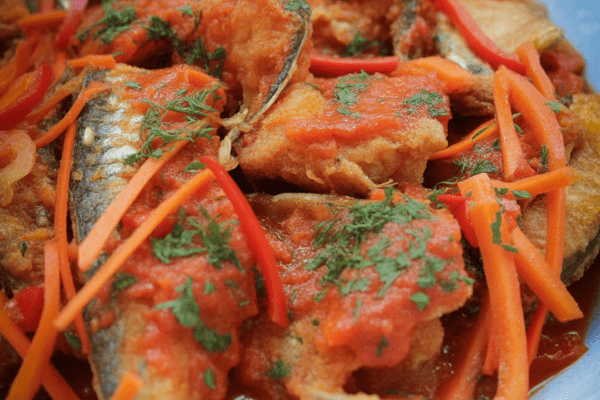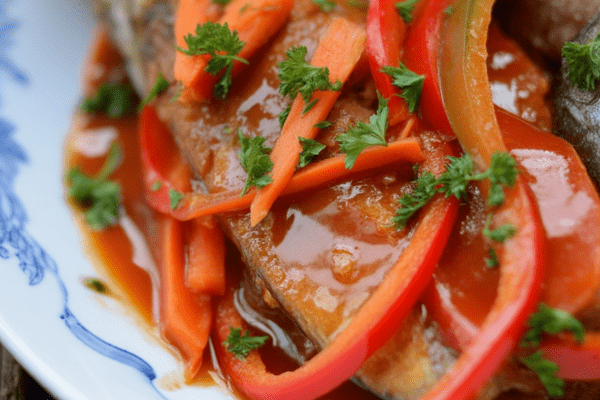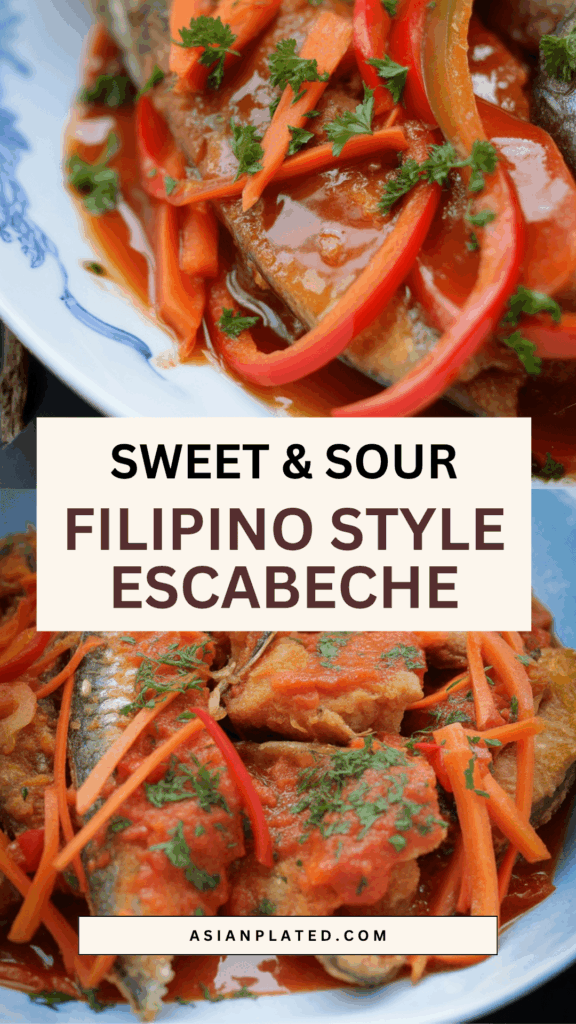If you ask me what I love about Filipino cooking, it’s the way it hits that sweet spot between flavors—literally. Filipino Style Escabeche is a perfect example: sweet, sour, a little salty, and so satisfying. It’s one of those dishes I grew up eating at family gatherings, usually served on a big platter with all those colorful bell peppers on top, looking like a celebration on a plate.

I always think of this as a “special but doable” recipe. It’s not something I make every weeknight, but it’s one I love pulling out for weekends, family lunches, or even when I want to treat myself with something that feels truly home-cooked.
What is Escabeche?
Escabeche is one of those dishes you’ll find in many cuisines, but our Filipino version has its own personality. It’s known for its sweet and sour sauce, made bright with vinegar and balanced by sugar. But the real signature here is banana ketchup. It’s such a Filipino ingredient—slightly sweet, a little tangy, and it gives the sauce its beautiful orange-red color.
Whenever I make this, I’m reminded of family parties where the table would be packed with dishes, and Escabeche would always be that eye-catching centerpiece with the peppers glistening on top. The bell peppers don’t just make it pretty; they add crunch and soak up all that sauce so every bite is flavorful.

How to make Filipino Style Escabeche
Whenever I’m cooking this, I like to start with the fish because that’s the real star. I usually use a big fish that I can cut into serving pieces. Tilapia is a go-to for me, but any firm white fish works well.
Here’s how I do it:
- Slice the fish into manageable pieces. I like to keep them big enough that they don’t break apart in the pan.
- Rub salt all over the fish. This step does more than season—it draws out a bit of moisture and firms it up for frying. I always let it sit a couple of minutes. That short wait really makes a difference.
While I wait, I heat up my oil. I use enough to shallow-fry the fish. You want that golden brown crust—it’s what helps the fish hold up to the sauce without falling apart. I remember the first time I made this, I overcrowded the pan and the fish steamed instead of frying. Learned my lesson! Now I do it in batches so each piece gets that lovely, crispy edge.
Once they’re cooked, I place them on paper towels quickly to catch extra oil, then onto the serving plate, ready for that gorgeous sauce.

Making the sauce
Now for my favorite part—the sauce. I love how the smell of garlic and onion sautéing fills the kitchen. It’s such a comforting start.
Here’s how I build the sauce:
- Heat a bit of oil in the pan.
- Add chopped garlic and sliced onions. I like cooking them until the onions are soft and just a little caramelized for deeper flavor.
- Then I pour in banana ketchup, vinegar, sugar, and water. The ketchup gives it that signature Filipino sweetness and color. Don’t rush the boil—it helps the vinegar mellow out so you don’t get too sharp a bite.
Next come the bell peppers and carrot. I always julienne them so they cook quickly but keep a bit of crunch. The color from the red and green peppers makes the whole dish pop—it’s one of those moments that makes you feel proud of how beautiful home cooking can be.
For thickening, I make a quick cornstarch slurry. It’s such a simple trick but gives the sauce that perfect clingy texture. I like mine on the thicker side so it coats the fish really well.
When everything’s ready, I pour that hot, glossy sauce all over the fried fish. That sizzle when the sauce hits the crispy fish is one of those small joys that makes cooking so rewarding.
Filipino Style Escabeche

There’s something wonderfully nostalgic about dishes that transport you straight to your childhood kitchen — and for many Filipinos, Escabeche does just that.
Ingredients
For the Fish:
- 2 lbs whole fish (tilapia, maya-maya, or your choice), cleaned and sliced into serving pieces
- ¾ cup cooking oil (for frying)
- 2 tablespoons salt
For the Escabeche Sauce:
- 2 tablespoons cooking oil
- 1 onion, thinly sliced
- 3 cloves garlic, chopped
- 2 thumbs fresh ginger, cut into thin matchsticks
- 1 red bell pepper, julienned
- 1 green bell pepper, julienned
- 1 carrot, julienned
- 3 tablespoons white vinegar
- 4 tablespoons banana ketchup
- 3 tablespoons white sugar
- 1 cup water
- 1 tablespoon cornstarch, dissolved in 2 tablespoons water
- Salt and ground black pepper to taste
Instructions
- Prepare the FishStart by rubbing salt all over the fish slices. Let them sit for about five minutes — this helps draw out any unwanted moisture and seasons the fish nicely.
- Fry to PerfectionHeat your oil in a deep frying pan. Once hot, carefully place the fish pieces in and fry them until golden and crisp on both sides. Remove and let them drain on paper towels, then arrange the fish on your serving platter.
- Make the SauceIn a separate pan, heat 2 tablespoons of oil over medium heat. Sauté the garlic, ginger, and onions until fragrant and the onions begin to soften.
- Add in the vinegar, banana ketchup, sugar, and water. Give it a good stir and let the mixture come to a gentle boil.
- Add VegetablesToss in the julienned bell peppers and carrots. Let these cook for around 3 minutes — just enough to keep their crunch and brighten the dish with their natural sweetness.
- Thicken the SauceSeason the sauce with salt and pepper to your liking. Then, pour in the cornstarch slurry and stir continuously until the sauce thickens to a rich, glossy consistency.
- ServePour the hot, flavorful escabeche sauce over the fried fish. Serve warm, preferably with a mound of steamed rice. The combination of the crispy fish and that sweet, tangy sauce is truly irresistible.
Notes
- Banana ketchup gives this dish its iconic flavor and color — don’t skip it!
- For a touch of spice, toss in a few slices of red chili or siling labuyo.
- Best eaten fresh, but leftovers taste even better the next day as the flavors meld.
Nutrition Information:
Yield: 5 Serving Size: 1Amount Per Serving: Calories: 665Total Fat: 44gSaturated Fat: 4gTrans Fat: 0gUnsaturated Fat: 38gCholesterol: 103mgSodium: 2798mgCarbohydrates: 21gFiber: 2gSugar: 13gProtein: 49g
Asianplated.com, occasionally offers nutritional information for recipes contained on this site. This information is provided as a courtesy and is an estimate only. This information comes from online calculators. Although allchickenrecipes.com attempts to provide accurate nutritional information, these figures are only estimates.
Related recipes to try cooking
If you’re feeling inspired to keep the Filipino flavors going, here are a few other fish recipes I turn to when I want something special:
Fish Escabeche (classic version)
This is a simpler take with fewer ingredients but just as satisfying. I make it when I want something quick but still want those sweet-sour flavors. Whole peppercorns add a nice punch here.
Fried Fish Adobo
Think of it as adobo’s crunchy cousin. I love serving this with a side of spiced vinegar for dipping. It’s perfect when you want something bold and savory with steamed rice.
Ginataang Galunggong
For days I want something comforting, this is my pick. The coconut milk sauce is rich and mellow, with ginger and fish sauce giving it depth. It’s one of those recipes that makes you want to go back for seconds (or thirds).
Escabeche is a dish that always feels like home to me. It’s special enough for celebrations but simple enough to make on a lazy Sunday. I hope you’ll give it a try and make it your own. Let the bright, sweet-sour sauce, the crunch of peppers, and the tender fish win over your table just like it has mine.
Try other recipes:

